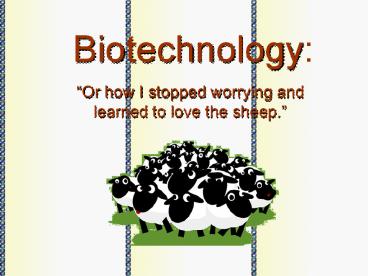Biotechnology: - PowerPoint PPT Presentation
Title:
Biotechnology:
Description:
Biotechnology: Or how I stopped worrying and learned to love the sheep. Restriction Enzymes Restriction enzymes are compounds first isolated in the 1970's They ... – PowerPoint PPT presentation
Number of Views:35
Avg rating:3.0/5.0
Title: Biotechnology:
1
Biotechnology
- Or how I stopped worrying and learned to love
the sheep.
2
Restriction Enzymes
- Restriction enzymes are compounds first isolated
in the 1970's - They function by selectively cutting DNA at
specific sequences
3
Restriction Enzymes
- These cuts usually occur in the following forms.
- The cut can be made straight across a base-pair
sequence resulting in a "Blunt End - The cut can be made in an offset manner leaving
exposed nucleotide sequences. These exposed
sequences are called "Sticky Ends"
Blunt End
Sticky end
4
Gene Splicing
- The presence of sticky ends allows segments of
DNA to be joined together. Since DNA strands
which have been cut by the same restriction
enzyme can easily bond together according to base
pairing rules.
5
Gene Splicing contd..
- This allows for genes to be "cut pasted"
between organisms. This can be seen with
production of human insulin. - The DNA sequence of insulin is identified and cut
out using a restriction enzyme. - A plasmid from E. coli is removed and cut open
using the same restriction enzyme - Since both fragments have complimentary sticky
ends the bind and the gene for human insulin is
integrated into the plasmid - The plasmid is then reinserted into a bacterial
cell. This cell will produce insulin and is
cultured. Human insulin can now be extracted and
provided to diabetics.
6
(No Transcript)
7
Gel Electrophoresis
- Gel electrophoresis is a technique used to
separate fragments of DNA. - Separates fragments as a function of size.
- Most types use Agarose to separate fragments.
- Agarose is a porous gel. It can allow the
passage of molecules through, however, larger
molecules move more slowly through it since they
cannot squeeze through the pores as easily as
smaller molecules.
Electrophoresis Apparatus
8
Electrophoresis Technique
- An agarose gel is casted with several holes
called wells at one end. - The gel is placed in an electrophoresis box which
is filled with an electrolyte buffer solution. - Samples of digested DNA are placed in the wells
- Electrical leads are attached to the ends of the
box creating an electrical potential across the
apparatus. - Because DNA has a negative electrical charge. It
is "pulled" towards the positive side of the
apparatus. - Also, since the smaller molecules travel faster
through the agarose. Over time this separates
the various sized fragments of DNA. - The gel is then removed and stained for DNA.
This results in a gel which shows several bands
of stained DNA.
9
Finished Gel
10
Gel Electrophoresis
11
DNA Fingerprinting
DNA is now a powerful tool in identification. Base
d on the fact that the amount of "junk DNA"
differs uniquely between individuals. Structural
genes are often separated by large regions of
repeating basepairs. The number of these repeats
is unique to an individual. Therefor when DNA
from a person is cut with a restriction enzyme,
the length of the fragments will be unique to an
individual.
12
DNA Fingerprinting Contd
- This will therefor produce a unique banding
pattern following a gel electrophoresis. - This test is highly accurate, and the probability
of another individual possessing an identical
banding pattern is estimated as around
114,000,000,000.
13
DNA Fingerprinting
14
Cloning
15
Cloning What it is
- Cloning is the process of making a genetically
identical organism through nonsexual means. It
has been used for many years to produce plants
(even growing a plant from a cutting is a type of
cloning). Animal cloning has been the subject of
scientific experiments for years, but garnered
little attention until the birth of the first
cloned mammal in 1997, a sheep named Dolly. Since
Dolly, several scientists have cloned other
animals, including cows and mice. The recent
success in cloning animals has sparked fierce
debates among scientists, politicians and the
general public about the use and morality of
cloning plants, animals and possibly humans
Dolly, the first mammal clone
16
Dolly A Mammal Clone
- Dolly
- In 1997, cloning was revolutionized when Ian
Wilmut and his colleagues at the Roslin Institute
in Edinburgh, Scotland, successfully cloned a
sheep named Dolly. Dolly was the first cloned
mammal. - Wilmut and his colleagues transplanted a nucleus
from a mammary gland cell of a Finn Dorsett sheep
into the enucleated egg of a Scottish blackface
ewe. The nucleus-egg combination was stimulated
with electricity to fuse the two and to stimulate
cell division. The new cell divided and was
placed in the uterus of a blackface ewe to
develop. Dolly was born months later.































